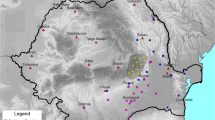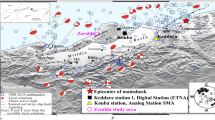Abstract
According to general seismic zoning maps, Moscow is in an area with a seismic intensity of 5, in which the maximum seismic effect is expected from remote deep-focal earthquakes in the Vrancea zone (Eastern Carpathians, Romania). In our previous studies, an earthquake with a hypocenter at a depth of 80–150 km in the Vrancea zone, a moment magnitude of Mw = 8.0, and a drop in stress of Δσ = 325 bar was used as a scenario earthquake for Moscow. A series of model acceleration time histories for ground vibrations was calculated for this earthquake for the reference local conditions of the Moskva seismic station (Moscow, Pyzhevskii per. 3). In this paper, these acceleration time histories are used to calculate the acceleration time histories and estimate the ground vibration parameters for an scenario earthquake at other sites on the territory of Moscow for which information on soil conditions is available. Since the epicentral distance is large (~1300 km), it can be assumed that changes in the shape and spectral content of the acceleration time histories at different sites in Moscow are only caused by different local conditions.
Similar content being viewed by others
References
Aptikaev, F.F. and Shebalin, N.V., Specifying correlations between the level of macroseismic effect and dynamic parameters of ground motions, Vopr. Inzh. Seismol., 1988, vol. 29, pp. 98–108.
Boore, D.M. and Joyner, W.B., Site amplifications for generic rock sites, Bull. Seismol. Soc. Am., 1997, vol. 87, pp. 327–341.
Glubinnoe stroenie slaboseismichnykh raionov SSSR (Deep Structure of Weakly Seismic Region of USSR), Moscow: Nauka, 1987.
Gusev, A.A. and Pavlenko, O.V., An earthquake modeling for seismic loads assessment in Moscow: Parameters and model ground motions, Stroit. Mekh. Raschet Sooruzh., 2009, no. 4, pp. 55–72.
Joyner, W.B. and Chen, T.E., Calculation of nonlinear ground response in earthquakes, Bull. Seismol. Soc. Am., 1975, vol. 65, pp. 1315–1336.
Mindel’, I.G., Trifonov, B.A., and Ragozin, N.A., Comprehensive seismoacoustic studies of engineering geological conditions of building sites in Moscow, Unik. Spets. Tekhnol. Stroit., 2006, no. 1, pp. 83–87.
Pavlenko, O.V., Nonlinear seismic effects in soils: Numerical simulation and study, Bull. Seismol. Soc. Am., 2001, vol. 91, no. 2, pp. 381–396.
Pavlenko, O.V. and Irikura, K., Changes in shear moduli of liquefied and nonliquefied soils during the 1995 Kobe earthquake and its aftershocks at PI, SGK, and TKS vertical array sites, Bull. Seismol. Soc. Am., 2002, vol. 92, no. 5, pp. 1952–1969.
Pavlenko, O.V. and Irikura, K., Estimation of nonlinear time-dependent soil behavior in strong ground motion based on vertical array data, Pure Appl. Geophys., 2003, vol. 160, pp. 2365–2379.
Pavlenko, O.V. and Irikura, K., Nonlinear behavior of soils revealed from the records of the 2000, Tottori, Japan, earthquake at stations of the digital strong-motion network Kik-Net, Bull. Seismol. Soc. Am., 2006, vol. 96, no. 6, pp. 2131–2145.
Pavlenko, O. and Wen, K.L., Estimation of nonlinear soil behavior during the 1999 Chi-Chi, Taiwan, earthquake based on stochastic finite-fault simulations, Pure Appl. Geophys., 2008, vol. 165, pp. 373–407.
Pomerantseva, I.V. and Solodilov, L.N., A study of the structure and seismicity of the territory of Moscow on the basis of surveying seismological method, no. 3 of Geoekol. Issled. Okhr. Nedr, Moscow: Geoinformmark, 1997.
Sevost’yanov, V.V., Mindel’, I.G., and Trifonov, B.A., Seismic hazard assessment for high-rise buildings in Moscow, Unik. Spets. Tekhnol. Stroit., 2006, no. 1, pp. 56–62.
The Global Seismic Hazard Assessment Program (GSHAP) 1992−1999, Ann. Geofis., 1999, vol. 42, no. 6, pp. 955–1230.
Wald, D.J., Quitoriano, V., Heaton, T.H., and Kanamori, H., Relationship between peak ground acceleration, peak ground velocity, and modified Mercalli intensity for earthquakes in California, Earthquake Spectra, 1999, vol. 15, pp. 557–564.
Author information
Authors and Affiliations
Corresponding author
Additional information
Original Russian Text © O.V. Pavlenko, 2017, published in Voprosy Inzhenernoi Seismologii, 2017, Vol. 44, No. 4, pp. 5–28.
About this article
Cite this article
Pavlenko, O.V. Acceleration Time Histories for a Scenario Earthquake in Moscow at Sites with Different Soil Conditions. Seism. Instr. 54, 437–460 (2018). https://doi.org/10.3103/S0747923918040060
Published:
Issue Date:
DOI: https://doi.org/10.3103/S0747923918040060




